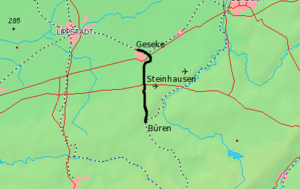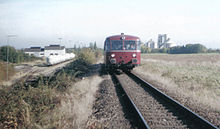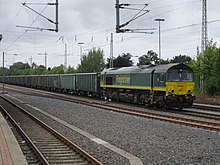Geseke – Büren railway line
| Geseke-Büren | |||||||||||||||||||||||||||||||||||||||||||||||||||||||||||||||||||||||||||||||||||||
|---|---|---|---|---|---|---|---|---|---|---|---|---|---|---|---|---|---|---|---|---|---|---|---|---|---|---|---|---|---|---|---|---|---|---|---|---|---|---|---|---|---|---|---|---|---|---|---|---|---|---|---|---|---|---|---|---|---|---|---|---|---|---|---|---|---|---|---|---|---|---|---|---|---|---|---|---|---|---|---|---|---|---|---|---|---|
| Route number : | 2963 | ||||||||||||||||||||||||||||||||||||||||||||||||||||||||||||||||||||||||||||||||||||
| Course book section (DB) : | 109i, 174e, 198q, 232q, 238f | ||||||||||||||||||||||||||||||||||||||||||||||||||||||||||||||||||||||||||||||||||||
| Route length: | 15.3 km | ||||||||||||||||||||||||||||||||||||||||||||||||||||||||||||||||||||||||||||||||||||
| Gauge : | 1435 mm ( standard gauge ) | ||||||||||||||||||||||||||||||||||||||||||||||||||||||||||||||||||||||||||||||||||||
| Categorization: | Branch line | ||||||||||||||||||||||||||||||||||||||||||||||||||||||||||||||||||||||||||||||||||||
| Expansion: | single track, not electrified | ||||||||||||||||||||||||||||||||||||||||||||||||||||||||||||||||||||||||||||||||||||
| Passenger traffic : | shut down | ||||||||||||||||||||||||||||||||||||||||||||||||||||||||||||||||||||||||||||||||||||
| Freight traffic: | Operation of two cement plants | ||||||||||||||||||||||||||||||||||||||||||||||||||||||||||||||||||||||||||||||||||||
| Mode of transport : | Deutsche Bahn | ||||||||||||||||||||||||||||||||||||||||||||||||||||||||||||||||||||||||||||||||||||
| Network area (s) : | ZRL , NPH | ||||||||||||||||||||||||||||||||||||||||||||||||||||||||||||||||||||||||||||||||||||
|
|||||||||||||||||||||||||||||||||||||||||||||||||||||||||||||||||||||||||||||||||||||
The railway line from Geseke to Büren branches off in Geseke south-east of the railway line Hamm – Warburg ( KBS 430), the main line of the Royal-Westphalian Railway Company . The line then ran as a single-track branch line in an arc around the Geseke urban area, further south via Steinhausen and the Haar to Büren, where it met the Almetalbahn from Paderborn to Brilon-Wald (also no more passenger traffic since 1981).
past
In 1895, after several years of investigation, a Prussian law on the construction of the Büren – Brilon Stadt (Almetalbahn) and Geseke – Büren railway was enacted. In 1898 the construction of the Almetalbahn and the connecting line between Geseke and Büren began. The route represents the originally planned route of the Almetalbahn from Büren, especially as requested by the city of Geseke and the district of Lippstadt . After the alternative and longer route to Paderborn had been decided, the connecting route was built after further interventions by the city of Geseke and the district of Lippstadt.
Both railway lines went into operation on July 1, 1900 (the Almetalbahn initially only on the Paderborn – Büren section). The connecting line between Geseke and Büren promoted the development of the cement industry in Geseke, which for a long time was the most important branch of industry for Geseke. This is how cement and lime works were built along the railway line - like a string of pearls - each of which was connected to the railway line by a siding . An iron foundry, a rubble dump and a substation were also connected to the industrial tracks. In 1935 an air base was built in the field corridor at the level of Störmede , which was connected to the railway line at the Fortuna cement works by a 2.1 km long track. Immediately after the war, the tracks were dismantled again in 1946. The former route and a bridge bearing over a dry stream in the field can still be seen today.
Due to the importance of the cement industry, the new “Geseke Zementwerke” stop was set up in 1950. Nevertheless, in 1952, regular passenger traffic was discontinued by the Deutsche Bundesbahn and replaced by a bus connection (now line 465 BahnBus Hochstift ). The edge of the platform at the “Geseke Zementwerke” stop, which was only used for two years, is still visible today.
In addition to the standard- gauge track systems, factory railways with 600 or 900 mm gauge for transporting the broken stones to the factory were in operation for the Geseker cement works until the end of the 1950s . From the quarry of the Meteor plant, there was even a 3 km long field railway through the western part of the city to the plant in the north near the train station. The "Meteorbahn" crossed under the route to Büren at the level of the cement works branch.
Not only did the companies have their own locomotives, freight carts and wagons for these railways, but almost all plants also had their own locomotives to move the standard-gauge state rail freight wagons. There were 46 verifiable industrial locomotives in Geseke, of which 18 were standard gauge locomotives and 28 were narrow-gauge locomotives.
In 1958, goods traffic to Büren was discontinued. A short time later, the section between Steinhausen and Büren was shut down and then dismantled. The remainder to Steinhausen was still used in freight traffic. With the electrification of the Hamm - Kassel line at the end of the 1960s, the entry of the Bürener line to the east side of the Geseker station changed. Up until this point in time, platform 1 at Geseke station formed the direct route to Büren. Due to necessary renovation work, the entrance from Büren was relocated east of the WP 19 level crossing into the main line in order to reach the freight station from there. The remaining track on the south side of WP 19 still served as an entrance to the granary and as a siding for diesel shunting locomotives.
When the new federal motorway 44 was built in 1972, the railway line was also given a bridge over the motorway so that it could continue to reach Steinhausen. Until 1993, the Bundesbahn only served one customer in Steinhausen, the Spardaka warehouse in Steinhausen. In 1992 the warehouse received 3,000 tons of goods (mainly fertilizers), which were delivered in 150 wagons. Up to this point in time, there were occasional special trips on the remaining route to Steinhausen (for example with a rail bus team on August 26, 1989).
During the one-year line closure for the expansion of the main line between Soest and Paderborn from 1993 to 1994, daily freight traffic to the cement works and the rubble dump could be maintained thanks to a construction track laid between Geseke and Paderborn. The eastern approach to Geseke station was changed during this construction project so that freight trains from Geseke Süd could no longer enter the Geseke freight station directly, but had to be pushed back from the west side.
The end for the section from the Milke Zement junction to Steinhausen came on November 30, 1993, as the repair costs of 150,000 DM for a bridge over a dirt road were no longer to be spent. The tracks were removed immediately after the closure on the section between the Milke and Steinhausen siding. The gravel bed is still visible in large parts of the route and not built over; the bridge over the A 44 is still there. The dismantled section of the route is therefore still dedicated as a traffic route. The railroad overpass over the dirt road has now been dismantled, and the route through the newly built bypass around Steinhausen is no longer available at the level of the motorway entrance.
Shortly after Geseke-Süd, a branch line branches off to the Fortuna plant of the Dyckerhoff company , on this branch line there were further connections to two other cement plants. On the one hand, this was the Westphalia cement works of the West German Portland-Zement- und Kalkwerke Gebr. Gröne and the coal cement works of the Westphalian Portland-Zementwerke coal & Co. Part used as a warehouse. The siding to the Westphalia plant is still there, but can no longer be used.
present
Today there is still goods traffic to the cement works in the south of Gesek. Until 2004, this was carried out daily by Railion from Geseke station. By the fall of 2011, the cargo area of the station was no longer in regular use, the line was of Lippstadt and Paderborn from the EGP and the WAB served. From 2006 to the end of 2007, EGP used a MaK 800 D from the Heilbronn Railway Museum , ex OHE, which was permanently stationed in Geseke, and was the last operational locomotive of this type. There are still sidings to the cement works Milke Zement and Fortuna (Dyckerhoff).
After extensive construction work, the Geseke train formation station was built in the previous freight area between summer and autumn 2011. It includes tracks 4 to 11. For this purpose, the entrance from the direction of Paderborn to track 4 has been removed. The facility can only be reached via a track connection from track 3 via the pull-out track in the direction of Lippstadt. The switches are electrically set by the train driver or shunter. Thus, no dispatcher needs to be present. It is of course questionable whether Geseke Süd will also be repaired again. After all, Railion had described the facility as indispensable to the city of Geseke when the Geseke Süd area was to be built over when planning Portland Street.
Milke is currently served by DB Railion with 294 from Paderborn, mostly Saturday / Sunday. The WLE travels from Lippstadt with blue dust containers up to twice a week for Enercon to Milke. The two ER20s and the Warsteiner locomotive are also used here. As a rule, EGP still serves Dyckerhoff at the weekend with 212 and hired 142 of the DP in double traction. The train formation was moved from the main line to the central station. Especially on Saturdays at lunchtime you can often see EGP and Railion shunting at the same time. Since work supplies for the Paderborn plant are also stored here, there is occasionally a lack of space.
Until the beginning of 2006, Geseke Süd was used by the private railways to assemble the freight trains, but then after derailment of the Dispotaurus of the PE (Prignitzer Eisenbahn) it was shut down. Since then it has had to be maneuvered on the line or there are two more installation tracks in the area of the Dyckerhoff junction. EGP has been operating cement traffic between Neustrelitz and Geseke since 2008 . Blue-painted 212s were used for shunting purposes, and the Dispotaurus-type locomotive was usually taken along un ironed and parked in the siding at the Dyckerhoff junction.
In September 2015, the line up to the Annelise cement was renovated for 1.4 million euros and both the rails and the sleepers were replaced. Essentially three companies have been serving the cement works since 2017. The EGP operates the Dyckerhoff work. Until recently, the WLE did the "last mile" south of Geseke independently, but the EGP is currently using a WLE rental locomotive. The two Milke Zement plants are operated by Freightliner with Class 66 locomotives. In addition, DB Cargo delivers container wagons with yellow-painted cement dust pressure containers from Max Bögl as part of single-wagon transport.
Historical dates
- 1895: 4th August: Prussian law for railway construction Büren - Brilon Stadt and Geseke - Büren
- 1898: Start of construction
- 1900: July 1st: the route opens
- 1950: Construction of the “Geseke Zementwerke” stop between Geseke Bf and Geseke Bbf
- 1952: May 15: cessation of passenger traffic
- 1959: May 31st: Freight traffic between Büren and Steinhausen ceased and the section was dismantled shortly afterwards
- 1966: September 1st: Geseke-Süd-Steinhausen freight traffic is discontinued, continued operation as a station track
- 1993: November 30th: Freight traffic to Steinhausen is shut down and the section between Milke and Steinhausen is dismantled
- 2004: Railion ceases freight transport to the remaining piece and various private railway companies take over freight transport
literature
- Geseke - Anst Milke in: The great archive of the railway lines in Germany. GeraMond Verlag 2012.
- With a familiar Bemmelton to the Bürener Land. In: Geseker newspaper. February 27, 1988.
- After 93 years, the Steinhausen Railway era ends. In: Geseker newspaper. November 27, 1993.
- Construction of the Steinhausen - Geseke railway line began 90 years ago. In: Westfälisches Volksblatt. January 11, 1989.
- The railway to the cement works and to Steinhausen in Dunker, Alfons: Geseker Album Volume VI, pp. 397–401.
Individual evidence
- ^ Helmut Mauermann: Störmede Air Base. A chronicle in pictures and words. Self published in 2005
- ↑ Lüüs, Edgar: The Meteor Railway. Geseker Heimatblätter No. 332 October 1989
- ↑ Beyer, Burkhard: Railway vehicles of the Geseker cement industry, Geseker Heimatblätter 1991, No. 345
- ↑ Ketelhake, Martin and Högemann, Stefan: Building materials hub in Westphalia: cement traffic in the Geseke area. Railway report 5/2019 ISSN 0178-4528




